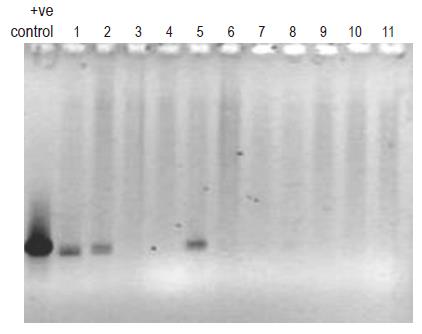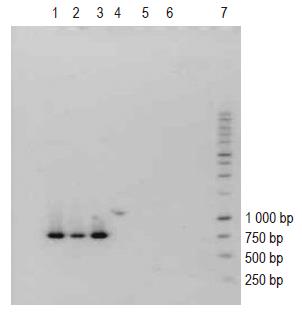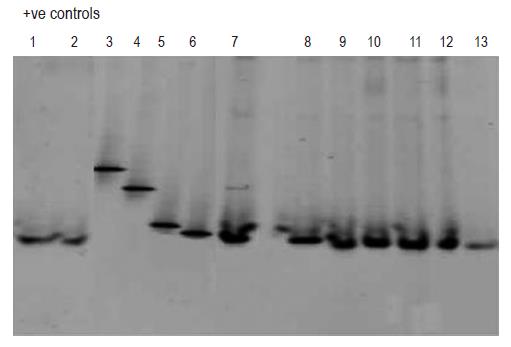Copyright
©2005 Baishideng Publishing Group Inc.
World J Gastroenterol. Dec 7, 2005; 11(45): 7142-7147
Published online Dec 7, 2005. doi: 10.3748/wjg.v11.i45.7142
Published online Dec 7, 2005. doi: 10.3748/wjg.v11.i45.7142
Figure 1 PCR profiles of total DNA recovered from human blood samples and of E coli DNA (control) obtained using primers BD1 and BD2 specific for bacterial 16S rRNA region.
Positive control: Chromosomal DNA from E coli. Lanes 1-11: total DNA extracted from human blood samples.
Figure 2 PCR profile of E coli chromosomal DNA.
Lanes 1-3: DNA amplified using primers BG1 and BG4 specific for E coli. Lanes 4-6: DNA amplified using primers BFR1 and BFR2 specific for Bacteroides spp. Lane 7: 1 kb standard DNA ladder.
Figure 3 DGGE profiles of the amplified region of bacterial DNA coding for 16S rRNA using primers F3 and Rev 2.
Positive controls: Lane 3. Staphylococcus aureus; Lane 4. Pseudomonas aeruginosa; Lane 5. Bacillus cereus; Lane 6. E coli; Lanes 1-2 and 7-13: bacterial DNA present in human blood samples.
- Citation: Pearce CB, Zinkevich V, Beech I, Funjika V, Ruiz AG, Aladawi A, Duncan HD. Using the polymerase chain reaction coupled with denaturing gradient gel electrophoresis to investigate the association between bacterial translocation and systemic inflammatory response syndrome in predicted acute severe pancreatitis. World J Gastroenterol 2005; 11(45): 7142-7147
- URL: https://www.wjgnet.com/1007-9327/full/v11/i45/7142.htm
- DOI: https://dx.doi.org/10.3748/wjg.v11.i45.7142















